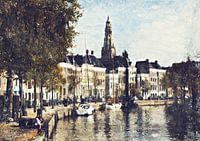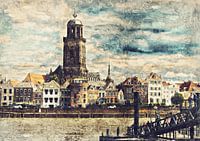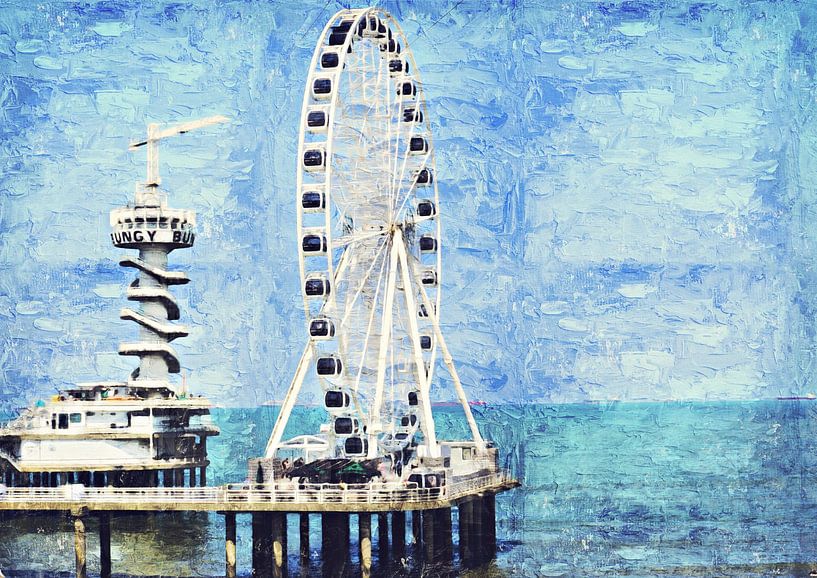Buy this landscape artwork Scheveningen, The Hague (painting) by Bert Hooijer on canvas, ArtFrame, poster and wallpaper, printed on demand in high quality.
About "Scheveningen, The Hague (painting)"
by Bert Hooijer
About the artwork
Historiography does not provide a definitive answer as to the age of Scheveningen. Naming research would have shown, as with other Dutch places ending in the suffix '-ingen', that its origins lie in the 10th or 11th century. The name in question appears for the first time in a grave register drawn up in part around 1284. It refers to an area described as a 'terra de Sceveninghe' (land of Scheveningen). It has been claimed that a family with the name Scheven - which owned a castle near Haarlem and settled in the area of Leiderdorp in the 14th century - had something to do with the village or with the name Scheveningen, but there is no evidence for this. Sometimes mentioned, but never substantiated, foreign influences are not demonstrable either. History suggests that Scheveningen's origins must have been purely Dutch. Within the 'terra de Sceveninghe' mentioned above, there was in all likelihood an older residential nucleus; one can think of an agricultural community, a hamlet, located a few kilometres further inland from the coast. Knowledge about that time is rather limited; however, the social geographer Dr J.K. de Cock has written something about this in an article entitled Scheveningen-Binnen and Scheveningen aan Zee, which can serve as substantiation. De Cock also returns to this older 'Sceveninghe' in a contribution in the reference work De bodem van 's-Gravenhage by E.F.J. de Mulder. In his view, the old hamlet - thought to date from the 12th or 13th century - disappeared under the sand as a result of prolonged sand drifts.

About Bert Hooijer
Hooijer Media & Graphics started out of a passion for designing and developing striking graphic design. I invent, create and design unique graphic designs. In very high quality because only the best is good enough... Read more…
 Netherlands
Netherlands Ordered in March 2025
Ordered in March 2025
 Netherlands
Netherlands Ordered in April 2021
Ordered in April 2021
 Germany
Germany Ordered in October 2023
Ordered in October 2023
 Netherlands
Netherlands Ordered in July 2018
Ordered in July 2018
 Germany
Germany Ordered in January 2022
Ordered in January 2022
 Germany
Germany Ordered in January 2021
Ordered in January 2021
 Netherlands
Netherlands Ordered in October 2020
Ordered in October 2020
 Germany
Germany Ordered in September 2021
Ordered in September 2021
 Germany
Germany Ordered in August 2025
Ordered in August 2025
 Netherlands
Netherlands Ordered in December 2024
Ordered in December 2024
 Netherlands
Netherlands Ordered in December 2024
Ordered in December 2024
 Germany
Germany Ordered in February 2024
Ordered in February 2024
About the material
ArtFrame™
Interchangeable Art Prints
- High-quality print
- Easily interchangeable
- Acoustic function
- Large sizes available
Discover the artworks of Bert Hooijer
 The beauty of AfricaBert Hooijer
The beauty of AfricaBert Hooijer The eyes of a lionBert Hooijer
The eyes of a lionBert Hooijer The Scottish HighlanderBert Hooijer
The Scottish HighlanderBert Hooijer The big 5Bert Hooijer
The big 5Bert Hooijer Sleeping lionBert Hooijer
Sleeping lionBert Hooijer King and QueenBert Hooijer
King and QueenBert Hooijer A lion familyBert Hooijer
A lion familyBert Hooijer lion family with cubsBert Hooijer
lion family with cubsBert Hooijer Lion family with 3 cubsBert Hooijer
Lion family with 3 cubsBert Hooijer The lion and the Scottish HighlanderBert Hooijer
The lion and the Scottish HighlanderBert Hooijer Windows different versionsBert Hooijer
Windows different versionsBert Hooijer Full lipsBert Hooijer
Full lipsBert Hooijer lion family with 3 cubsBert Hooijer
lion family with 3 cubsBert Hooijer Lion family with 1 cubBert Hooijer
Lion family with 1 cubBert Hooijer View from a wooden windowBert Hooijer
View from a wooden windowBert Hooijer lion family with 1 cubBert Hooijer
lion family with 1 cubBert Hooijer Groningen Netherlands (painting)Bert Hooijer
Groningen Netherlands (painting)Bert Hooijer Deventer (painting)Bert Hooijer
Deventer (painting)Bert Hooijer The Scottish HighlanderBert Hooijer
The Scottish HighlanderBert Hooijer Lion family with 1 cubBert Hooijer
Lion family with 1 cubBert Hooijer













 Jetty piers
Jetty piers Joyful Moments
Joyful Moments Landscapes
Landscapes Nostalgic Memories
Nostalgic Memories Oceans and seas
Oceans and seas Oil painting
Oil painting Scheveningen
Scheveningen Serene Peace
Serene Peace Water
Water the Hague
the Hague









